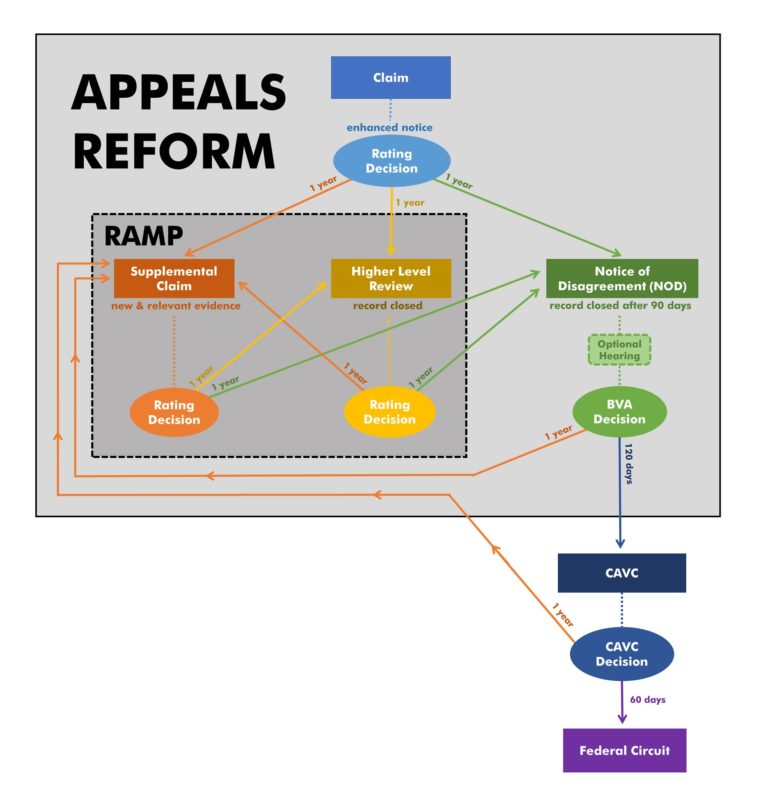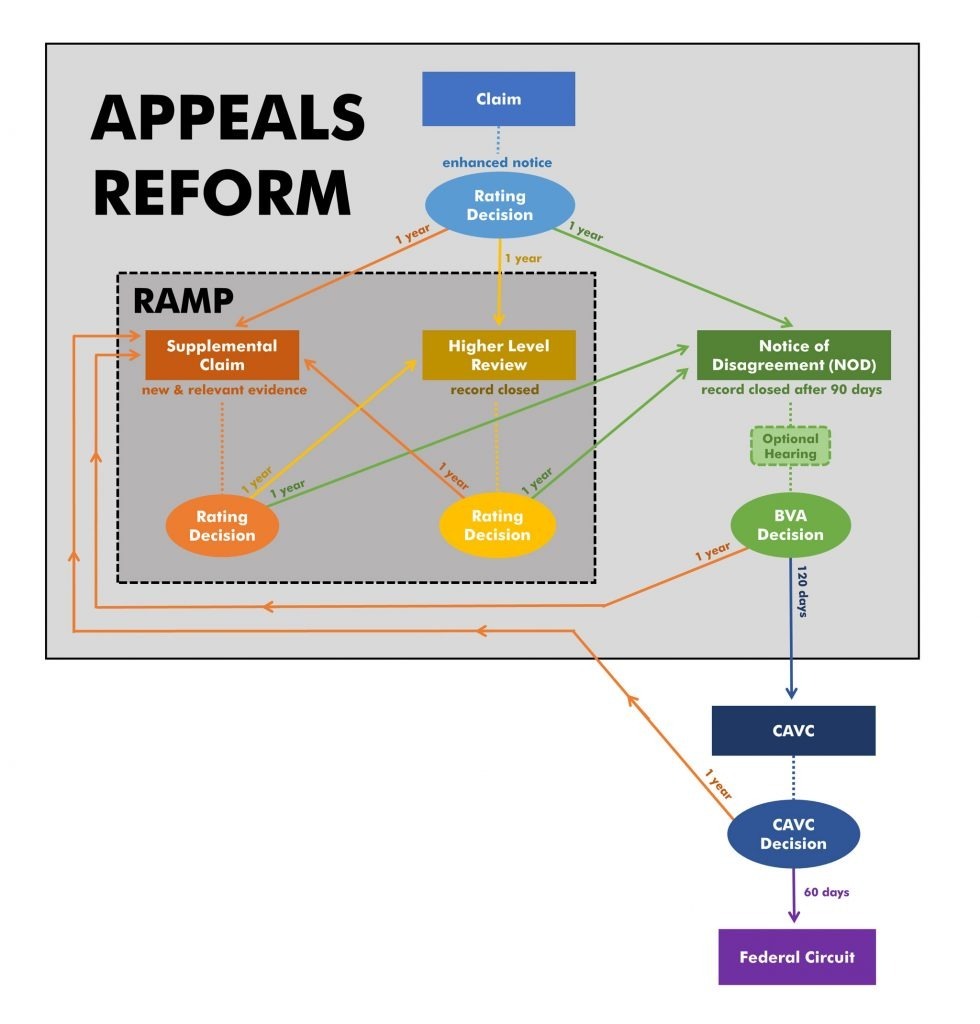CCK Live: Revisiting the Rapid Appeals Modernization Program (RAMP)

In November 2017, VA announced a new initiative called the Rapid Appeals Modernization Program (RAMP). RAMP is an invitation-only pilot program, meant to test the VA’s new disability compensation appeals process mandated by the Veterans Appeals Improvement and Modernization Act of 2017. Since the first RAMP letters were sent out to veterans in November 2017, new information about RAMP and the new appeals process has become available.
Note: On February 19, 2019 the Veterans Appeals Improvement and Modernization Act (AMA) was officially implemented, thus ending the Rapid Appeals Modernization Program. The most up-to-date information on the AMA can be found on our page: Veterans’ Appeals Reform.
Specifically, the Government Accountability Office (GAO) issued a January report on the claims that have already been processed in RAMP and the challenges VA faces in implementing the new appeals process. Then, on January 30, 2018, the House Veterans Affairs Committee held a hearing to discuss the implementation of the appeals reform act.
In this post, we will summarize our evolving knowledge about RAMP and the new appeals process. We will also give some background about the legacy appeals process that may help veterans decide which system is right for their claim. To help illustrate, we made diagrams that represent the legacy appeals process and the new appeals process.
You may also want to check out CCK’s latest Facebook Live discussion – RAMP Revisited. In our first discussion about RAMP, we were skeptical about the benefits of opting into an untested program that did not allow veterans full access to the new appeals system. But as reports on RAMP come in, CCK feels more optimistic about the potential benefits of the program.

The Legacy Appeals Process
 The legacy appeals process is the current VA appeals process (not including RAMP). Veterans who have filed (or will file) appeals before February 2019 are, by default, participating in the legacy appeals system unless they received a RAMP invitation letter and chose to opt in to RAMP.
The legacy appeals process is the current VA appeals process (not including RAMP). Veterans who have filed (or will file) appeals before February 2019 are, by default, participating in the legacy appeals system unless they received a RAMP invitation letter and chose to opt in to RAMP.
To read in-depth about this process, check out our claims and appeals process overview post. Briefly, the part of the process that takes place within the Department of Veterans Affairs can be found inside the gray box. Claims are initially submitted to the veteran’s Regional Official and stay there when appealed until the veteran submits a Form 9. VA Form 9 – also called a Substantive Appeal – appeals a decision from the RO to the Board of Veterans Appeals (known as the Board, or BVA).
On average, it takes about six years after receiving a Rating Decision to work its way through the system and receive a Board decision (“BVA Decision” in the diagram). From the time veterans submit Form 9 (to appeal to the Board), it takes an average of three years for the Board to issue a decision.
The backlog of claims waiting to be reviewed by the Board is part of the motivation for reforming the VA appeals process.
Appeals Reform: The New Appeals Process
The new appeals process (a.k.a. the new law, the Act, the Veterans Appeals Improvement and Modernization Act of 2017, appeals reform) is the new, three-lane appeals process that has not yet begun. The earliest the new system will go into full effect is February 2019. VA is optimistic it will meet that start date, but it may be longer than that if things don’t go as planned.
In contrast to the linear legacy appeals process, veterans will be able to choose which of three appeal lanes will be most appropriate for their claim. Even after veterans have selected a lane for their initial appeal and received a decision, they will be able to choose between the two other lanes if they decide to appeal again. After each appeal decision, veterans will have one year to gather evidence, if necessary, and choose the lane to which they would like to appeal.

In the new system, if a veteran disagrees with their initial rating decision, they can choose one of three appeal lanes: the Higher Level Review lane, Supplemental Claim lane, or Notice of Disagreement (NOD) lane (also referred to as the Board lane).
Higher-Level Review Lane
In the Higher-Level Review lane, veterans’ claims will be review “de novo.” This means a senior claims adjudicator at the VA will take a look at their entire claims file. In this lane, the record is closed, meaning veterans cannot submit new evidence. The higher-level reviewer will look only at the records already in the veterans’ file at the time of the initial decision.
For those familiar with the legacy appeals process, the higher-level review lane is similar to the optional “de novo” review from a VA’s appeals reform implementation plan states that many DROs will be trained as Higher-Level Reviewers as VA transitions to the new appeals process.
If a veteran is denied in their Higher Level Review decision, they can appeal to the Supplemental Claim lane or the NOD lane within a year.
Supplemental Claim Lane & “Enhanced Notice”
In the Supplemental Claim lane, veterans must submit new and relevant evidence to be reviewed by adjudicators at the veterans’ Regional Office. In the legacy appeals process, veterans often struggle to know exactly what kinds of evidence they need to support their case. One part of the new appeals process – what VA is calling “enhanced notice” – will hopefully help veterans with this problem.
In the new appeals system, veterans will receive enhanced notice rating decisions. Though we have not yet seen examples of enhanced notice decisions, VA says that they will be more explicit about the evidence each veterans’ case is lacking. Each VA claim requires evidence to support each of the elements of service connection – 1) a current diagnosis; 2) an in-service disease, injury, or event; and, 3) a medical nexus, or link, between the in-service disease, injury, or event and the diagnosis. In enhanced notice decisions, VA will identify which of these elements of your case they believe needs more evidence or support.
If a veteran is denied in their Supplemental Claim decision, they can appeal to the Higher Level Review lane or the NOD lane within a year.
Notice of Disagreement Lane (a.k.a. The Board Lane)
In the Notice of Disagreement (NOD) lane, veterans can take their appeals directly to the Board of Veterans Appeals (BVA or the Board). At the Board, claims are reviewed and adjudicated by veteran’s law judges – attorneys trained in veteran’s law.
Within the Board lane, veterans will be able to choose whether or not they want to submit new evidence and whether or not they want a hearing with a veteran’s law judge. If the veteran does want to submit new evidence, they are encouraged to do so when they submit their NOD to the Board. After their submission of the NOD, however, they will be able to submit new and relevant evidence for up to 90 days.
If a veteran is denied in a Board decision, they can appeal to the Supplemental Claim lane or the Higher Level Review lane within a year. Alternatively, they can follow the traditional appeal path and take their claim to the Court of Appeals for Veterans’ Claims (CAVC or the Court).
NOTE: Three lanes or five lanes?
Some officials have been describing the new appeals process as having five lanes. This simply refers to the Higher Level Review lane, the Supplemental Claim lane, and the three options available within the Board lane. Veterans in the Board lane can choose to
- have a hearing and submit new evidence,
- have no hearing and submit new evidence OR have a hearing and submit no new evidence, or
- have no hearing and submit no new evidence.
We will be describing the new process as having three lanes, not five.
Court of Appeals for Veterans Claims
Once their claim is appealed outside of the VA (outside of the gray box, in the diagram below) to the Court of Appeals for Veterans Claims (known as the Court or CAVC), veterans will still have the opportunity to take their claim all the way back to the Supplemental Claim lane, provided they gather new and relevant evidence to submit. They must submit that new and relevant evidence within a year of the Court’s decision. So, even veterans who receive unfavorable CAVC decisions will be able to maintain their effective date and continue to pursue their case within the VA system.
How does RAMP fit into Appeals Reform?
RAMP – the Rapid Appeals Modernization Program – is a pilot program for appeals reform, a test before VA fully implements the new appeals system. At this stage, RAMP only allows veterans to participate in the Higher Level Review lane and the Supplemental Claim lane, but not the Notice of Disagreement/Board lane.
In the appeals reform diagram above, one can see the parts of the new process available to RAMP participants by looking at the darker gray box contained by the dotted line. Once they have opted into RAMP, veterans will not be able to leave this box until the appeals reform system is fully implemented (VA’s goal is February 2019).
VA has been inviting more veterans to opt in to RAMP each month since November. Veterans can only choose to participate in RAMP if they have received a letter from the VA specifically inviting them to opt in to the program.
What we know about RAMP so far
Now that RAMP has been up and running for a few months, VA is beginning to share data about the program. So far, VA has sent out 15,500 RAMP invitation letters since the beginning of November and continues to invite more veterans to participate each month. Of those 15,500 veterans invited, 332 veterans (with a total of 462 appeals) have decided to withdraw from the legacy appeals process and opt into RAMP – that’s about 3 percent of the veterans invited.
VA reports that 61% of appeals processed in RAMP have been granted, as opposed to 25% of all claims granted in the legacy system. CCK attorney Brad Hennings, a former veterans law judge, points out that the word “grant” could mean a grant of service connection, but, for example, the RO then could assign a 0% rating (a noncompensable rating) for which VA does not pay any monthly compensation.
As mentioned, veterans who opt in to RAMP are not yet able to choose the NOD lane that goes to the Board. So, of the two available lanes, about two-third of participating veterans have chosen the Higher Level Review lane, and the remaining one-third have chosen the Supplemental Claim lane.
In both of these lanes, VA is meeting its goal of issuing a decision in less than 125 days (for these two lanes). The average time it has taken to adjudicate claims in RAMP is 37 days, as of January 30. Note, however, that fewer veterans than expected have opted in to RAMP, so adjudicators likely have lighter workloads now than they will in the future.
Thinking about opting in? Here’s what you should know
Clearly, RAMP is a new program and our knowledge about its effectiveness and efficiency are still evolving. But, from what we have learned, CCK is optimistic that some claims will be successful (and resolved much more quickly) in the RAMP system than the legacy system. In fact, CCK plans to discuss the benefits of RAMP with certain clients and offer to have them put their claims in RAMP.
If you’re thinking of opting in to RAMP, here are a few things you should consider before withdrawing from the legacy appeals process:
RAMP Invitation Letters
You cannot opt into RAMP if you have not received a RAMP invitation letter. So far, these letters have mostly been sent to veterans who have filed a Form 9 and are waiting for their claims to be certified to the Board. In February, however, VA is sending a batch of RAMP letters to veterans who have recently appealed their claims with a Notice of Disagreement (NOD).
If you have not yet received a RAMP letter, you may still get one in the coming year. VA is sending more and more letters every month. If your case has already been certified to the Board, however, do not expect to receive a RAMP letter. VA has confirmed that these veterans will not be invited to RAMP.
If you got a RAMP letter months ago, you can still opt in. As far as we know, there is no deadline for opting into RAMP once you receive an invitation letter. So, if you were skeptical at first but would now like to opt in, you should still be able to opt in to RAMP.
To opt into RAMP, you must withdraw your claim from the legacy appeals process. Once you have opted in, you cannot return to the legacy appeals process. You will only have access to the Supplemental Claim lane and the Higher Level review lane until February 2019, or whenever the VA fully implements the appeals reform act. And once the act is implemented, you will only be able to participate in the new appeals process.
In the House Veterans Affairs Committee hearing, an official from the Government Accountability Office (GAO) expressed doubts about VA’s ability to successfully implement the new appeals process by February 2019. According to GAO, VA has not created a sufficient plan for allocating resources between the new appeals process and the legacy process. Additionally, because the NOD lane is not an option in RAMP, VA will not be able to predict how many veterans will choose the NOD lane and thus will not have an accurate idea of how many new employees will be needed to handle the workload. This could potentially lead to an implementation date that is later than VA’s predicted February 2019 date. It could also cause some delays and confusion in processing when RAMP ends and the new system is implemented.
No appeals to the Board, but potentially shorter wait times
As mentioned, RAMP only grants veterans partial access to the new appeals process. Veterans who opt in will not be able to take their claims directly to the Board and will not be able to appeal decisions they receive in the Supplemental Claim and Higher Level Review lanes to the Board until at least February 2019.
Veterans who are close to getting a hearing with the Board or have already had their claims certified to the Board will likely not choose to opt in to RAMP so that they can keep their place in line for the Board. But many veterans still face years of waiting time for a Board decision. On average, veterans who have submitted a Form 9 wait three years before receiving a Board decision. So, opting into RAMP and waiting until February 2019 (or a little longer if VA does not meet its implementation goal) may still be the fastest option for some veterans.
Relatedly, when the NOD/Board lane opens to veterans in the new system, legacy claims at the Board level will be processed separately from claims in the new system. This matters because veterans who opt into RAMP will essentially be able to bypass the enormous legacy appeals backlog at the Board. But again, RAMP – which is supposed to test out the new appeals process – does not include access to the NOD/Board lane. So there is significant concern from lawmakers and veterans advocates that VA will have no information about whether the new processing system at the Board will work as planned.
As more information about RAMP and the implementation of appeals reform come out, we will do our best to keep you updated.
About the Author
Share this Post
